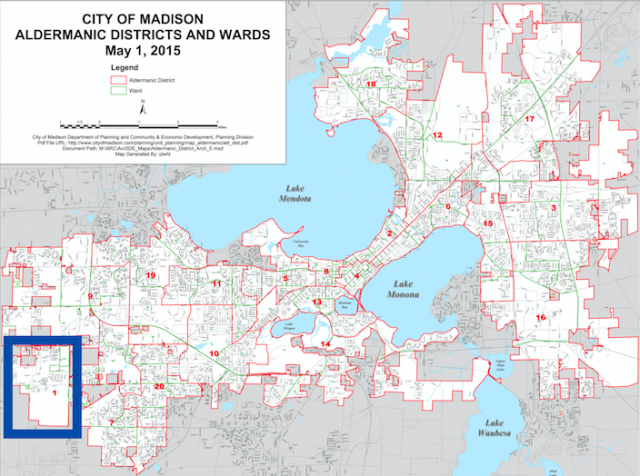






 Residents of District 1, on Madison’s far west side, are trying to form a neighborhood association. (City of Madison Department of Planning and Community & Economic Development, Planning Division)
Residents of District 1, on Madison’s far west side, are trying to form a neighborhood association. (City of Madison Department of Planning and Community & Economic Development, Planning Division)
Joseph Ryan believes that there is a disconnection between his far west side neighborhood and the city of Madison at large.
“We live in what feels like a hidden forest off the beaten path,” said Ryan, who is an active member of District 1’s Valhalla Valley community. “It feels likes a microcosm of Madison.”
While Ryan admires his tight-knit community, he also wants a stronger connection to his city. To that end, he and other residents are forming District 1’s first neighborhood association.
Ryan got the idea when District 1 Alder Barbara Harrington-McKinney invited him and other residents to a meeting to discuss neighborhood issues. It became clear that forming a neighborhood association to work together in an ongoing manner made sense.
“We decided that we should come together to officially start a neighborhood association,” Ryan said.
Neighborhood associations are critical because they devote time and energy to improving and enhancing specific geographic areas, rather than a city at large. They also give government officials, developers and other community members a chance to enhance the quality of life in that community.
The city is required to keep associations informed about items relating to their areas, such as proposals for new developments, updates of public spaces or zoning changes. As a result, these associations often play vital roles building bridges between neighborhood residents and city officials.
“Neighborhood association are ways cities get information within an area to inform residents while getting residents’ feedback,” said Jule Stroick, neighborhood planner for the city of Madison who is working with District 1 to form their neighborhood association. “If you’re recognized by the city, we automatically let the neighborhood association know what’s going on in the district which then triggers people to communicate.”
Of the 20 districts in Madison, there are roughly 17 neighborhood associations. But city workers like Stroick are working to form neighborhood associations in every district.
Forming a neighborhood association requires four relatively simple steps, including contacting the relevant alderperson and placing a public notice. Neighborhood associations are also required to meet certain standards which include keeping written procedures, making geographical distinction, having a board and holding open community elections.
For District 1, the process has been fairly smooth. Over the summer, neighborhood leaders will host a community day to kickstart involvement with the association.
“It’s all about getting the community involved and gaining participation. In District 1 we have a lot of groups already formed so reaching out to those has been helpful,” said Ryan. “We are still in the infancy of this process though and will be working as hard as we can to garnish interest and involvement from our community.”
|
|
|
Welcome to the Madison Commons, a website designed to provide news and information about all of Madison's neighborhoods and a crossroads for the discussion of community issues. The name comes from the idea of a village commons, a place for news, talk, debate, and some entertainment, too, that's open to everyone.
All rights reserved. Read more about the Madison Commons and its partners.

